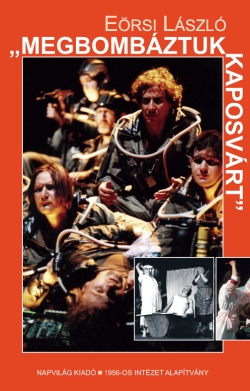László Eörsi: „We bombed Kaposvár”
Budapest: Napvilág Kiadó–1956-os Intézet Alapítvány, 2013, 222 p.
 |
SUMMARY
During the 1970's of Hungary's Kádár-era, the period of the state-socialism, the Csiky Gergely Theater in the city of Kaposvár became the most influential theater in the country. This was primarily due to the work of a young gen-eration of stage directors (Gábor Zsámbéki, László Babarczy, Tamás Ascher and others), whose productions broke entirely with the convention of social-ist realism, with ossified theatrical solutions and artistic routines lacking any innovation. They aimed at manifesting their distinct positions on current af-fairs. This attitude, in addition to their attention to high aesthetic standards, was one of the reasons why a number of their productions began to push the boundaries of what was tolerated by official cultural politics.
The first serious tension arose at the company's guest performance at the Vigszinház theater in Budapest, as it performed the operetta State Department Store in a way that ridiculed the regime. Authorities dispatched a sizeable police force to the theater, in order to prevent the event from turning into a public protest. During the season of 1981-82, two performances drew ire of the top cultural politicians. Shakespeare's Richard III, in the interpretation performed by the Kaposvár company, resembled all too much the introduc-tion of martial law in Poland by Wojciech Jaruzelski—and this became the source of serious friction with the authorities.
The most controversial (and successful) play in this period proved to be the drama Marat/Sade by Peter Weiss. The performance's most provocative so-lution was the use of an image of Corvin passage (a location in Budapest known to be the center of armed resistance during Hungary's 1956 upris-ing) as a background to a scene in which the announcer was weeping with a cobblestone in his hand. The scandal went as far as the party's Politburo and led to minister Béla Köpeczi publicly criticizing the performance. In private, even first secretary János Kádár expressed his disapproval. The play has nevertheless achieved international recognition and it also helped that the Kaposvár party leadership took a stance in support of the theater.
Ultimately, the play escaped being banned and the theater was allowed to continue its work, although frequent denunciations ensured that political pressure remained up until 1988-89.
The second part of this volume telis the story of the Kaposvár theater after the political transition: following eight to nine years of relative indepen-dence, political interference returned to complicate the life of the company. Although it remained one of the most distinguished among Hungarian the-aters, its local political support significantly weakened by the turn of the millennium. The city government led by the centre-right Fidesz–KDNP was not positively disposed toward the productions—directed, in large part, by János Mohácsi—that kept on addressing current issues and were often criti-cized for being too provocative and out of tune with public taste.
Many found the play 56 o6/őrült lélek vert hadak, premiered on the fiftieth anniversary of the 1956 uprising, to offend Hungarian identity (a claim hard to make sense of). Such sentiments were further fuelled by an extreme-right website that launched a campaign against the performance. This provided an excellent pretext for the city government to initiate substantial changes in the theater's management and artistic direction.
The major change came in the spring of zoo8 when György Schwajda was named as the new director. Under his management, the theater's profile shifted significantly toward mainstream entertainment. In the process, the theater has lost almost entirely its former image and cultural role that was once praised as the "Kaposvár-phenomenon."
It was thus ultimately political interference that led to the decline of this long-established workshop, well-known throughout Europe: ultimately, the conservative parties gaining dominance under democratic conditions have proven to be more succesful in enforcing their own vision than the former cultural bosses under state-socialism.

